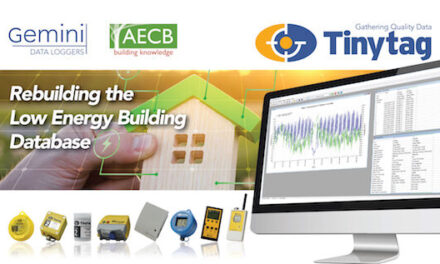 With fuel prices rising and legislation to control carbon emissions tightening, many steam using organisations are looking for ways to save energy. Spirax Sarco’s Andy Cowan discusses the importance of measuring energy consumption through steam flowrate and how to go about it
With fuel prices rising and legislation to control carbon emissions tightening, many steam using organisations are looking for ways to save energy. Spirax Sarco’s Andy Cowan discusses the importance of measuring energy consumption through steam flowrate and how to go about it
The first step in making users responsible for the energy they use is to measure their consumption, and this effectively puts metering equipment at the heart of any effort to monitor and target energy usage. According to the Carbon Trust, simply monitoring energy consumption using automatic monitoring and targeting (M&T) equipment typically helps organisations to reduce their energy costs by around five percent.
It is vital to choose a flowmeter type that takes into account all the needs of metering steam – a relatively slow flowing, high temperature fluid with varying density, often feeding variable demand and with entrained moisture that can damage unsuitable meter types.
 Meter accuracy is a significant factor in equipment selection, but turndown, which is the ratio of the maximum and minimum flow rates the meter can measure, is often even more important. High turndown minimises the chance of ending up with a meter that cannot handle the required range of flow rates.
Meter accuracy is a significant factor in equipment selection, but turndown, which is the ratio of the maximum and minimum flow rates the meter can measure, is often even more important. High turndown minimises the chance of ending up with a meter that cannot handle the required range of flow rates.
Ensuring steam metering accuracy
Metering steam presents a number of particular technical challenges. For example, many steam meters measure volumetric flow, but steam is a compressible fluid, which means variations in temperature and/or pressure also vary the density of the fluid. As a result, accurate steam metering often means measuring temperature and pressure as well as flow. In addition, steam meters must handle high temperatures, withstand erosion and remain accurate at relatively low velocities.
Selecting the right meter
As already mentioned, high turndown is good insurance against changing demand. Whether flow rates increase or decrease, a high turndown meter is more likely to meet changing requirements than a low turndown device, avoiding the cost of meter replacement.
The properties of steam mean that some types of meter that are commonly used for other fluids are not generally appropriate. Of the technologies that are suitable, it’s often a question of picking the one with the right combination of pros and cons for each application.
 What’s available?
What’s available?
- Coriolis flowmeters directly measure mass flow rate. They have one or more bent, straight, or U-shaped vibrating tubes in the fluid stream. These tubes twist as the fluid passes through them and the degree of twisting is directly proportional to mass flow.
- Orifice plates measure the pressure drop as the steam passes through a circular orifice. The differential pressure across the plate can be used to calculate the flow. A properly designed system can achieve a turndown of between 4:1 and 5:1.
- Pitot tubes can be cost effective for large bore pipes. They enable users to calculate velocity based on the pressure generated in an open ended tube facing the flow. Because a simple Pitot tube only samples a single point, accurate placement of the nozzle is critical. Averaging pitot tubes take samples from several points across the diameter of the pipe, giving a more representative measurement.
- Turbine meters have a multi-bladed rotor mounted at right angles to the flow and suspended in the fluid stream on a free running bearing. The speed of rotation is proportional to the volumetric flow rate of the steam. They offer a typical turndown of 10:1 and ±0.5% accuracy.
- A variable area meter consists of either a tapered bore with a straight sided float or a straight bore with a tapered float. When the fluid passes through the bore, the float’s position depends on the force of the fluid and gives a linear representation of the flow rate.
Applications
The physical properties of steam and the characteristics of different applications within steam systems make the use of many types of meter inappropriate.
Some types of meter offer very limited turndown ratios of 4 or 5:1, such as orifice plates and Pitot tubes. However, these simple, rugged and low cost meters can still be useful. Orifice plates are commonly used where the flow rate remains fairly constant, or where trending information is more important than precise measurements, such as on the steam main from the boiler. Insertion Pitot tubes are sometimes used to get a preliminary indication of the steam flow rate before choosing the best permanent solution.
The high turndown ratio achievable with meters in other fluids may be impossible to realise with steam. For example, vortex meters may achieve a turndown ratio of 25:1 in applications where the top velocity of the fluid approaches 75m/s. However, steam may contain water droplets that could cause serious damage at such high speeds, so steam pipework is generally sized to produce a maximum recommended velocity of 35m/s, reducing the turndown ratio of a vortex meter to closer to 12:1.
Some vortex meters try to overcome the problem by restricting the bore of the pipe and speeding up the flow through the meter. However, condensate in steam lines must be able to drain freely, and in a horizontal line, anything that creates obstructions such as a concentrically reduced bore in the pipe will stop that from happening.
Some meters are also vulnerable to erosion. For example, turbine meters have multiple moving parts and wet or dirty steam could erode the blades or cause bearing wear. That’s one reason why these meters tend to be used only for superheated steam and not saturated steam.
Similarly, the sharp edges of an orifice in an orifice plate or the precise shape of the bluff body in a vortex meter is critical to maintain accuracy, so any erosion may be problem. In contrast, it’s only the cross-sectional area of the float in an inline variable area meter that affects the reading, so erosive wear is not generally an issue.
Inline variable area flowmeters are often used in the float displacement mode for metering the steam supply to individual processes or to track the output of small boilers. The differential pressure across the float is usually preferred for metering boiler houses and large plants, where it’s easier to justify the added cost of the differential pressure cell.
Target variable area (TVA), flowmeters, pictured below, operate in a similar way, but rather than measuring differential pressure, they measure the force caused by the deflection of a cone (the float) using high quality strain gauges. This removes the need for differential pressure transmitters.
TVA meters typically offer the best overall metering performance. For example, Spirax Sarco TVA meters are accurate to ±2% over a turndown of 50:1.
The choice is yours
Finding ways to improve the efficiency of steam systems is a growing priority for many organisations and selecting the right meter is the natural first step. However, with such a large choice of flowmeters and a range of variables to consider, choosing the right meter can be a hard decision. If in doubt contact a trusted steam specialist such as Spirax Sarco for more information.
Spirax Sarco
T: 01242 535 574





